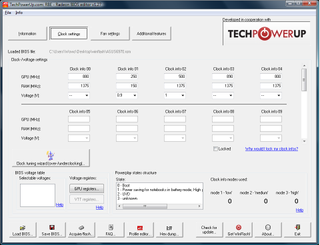Curbing Your GPU's Power Use: Is It Worthwhile?
In many cases, the graphics card is the most power-hungry component in a PC. The enthusiast community is no stranger to CPU tweaking, so why hasn't GPU modification caught on? We're going to see just how much you stand to gain (or lose) from tweaking.
AMD’s Radeon HD 6970
AMD’s Radeon HD 6970
AMD's Radeon HD 6970 is an altogether different beast compared to the company's Radeon HD 5870. We were pleasantly surprised to see that idle frequencies stay the same, regardless of any manual modifications to the core and memory clocks. The presence of a secondary BIOS on the card also means we have another safety net to recover from a bad flash, rather than ending up with a non-functional card.

Unfortunately, the card we have (Asus’ EAH6970/2DIS/2GD5) refused to work with any modified BIOS settings. Disappointed, we limited ourselves to just changing core and memory clocks. After all, we only modified the 5870’s BIOS to work around its odd clock behavior. To change the card's operating voltage, we used Asus’ SmartDoctor utility.
Asus’ SmartDoctor let us to bypass the BIOS and change the GPU operating voltage directly, though it's limited to changing operating voltage in 3D mode. We noticed that after tweaking voltages, those changes are not reflected in other utilities, such as GPU-Z or AMD Overdrive. They simply report the voltage value written in the BIOS.
We settled on several settings for testing. In addition to default clocks (890/1375 MHz) and UVD clocks (500/1375 MHz), we played with lower memory clocks (890/1030 MHz and 500/1030 MHz). Together with voltage adjustments, we came up with a total of seven settings to test.
| Core and Memory Clock | Chip Voltage |
|---|---|
| 890/1375 MHz (full clock default settings) | 1.175 V |
| 890/1375 MHz | 1.1 V |
| 890/1030 MHz | 1.175 V |
| 500/1375 MHz (UVD default settings) | 1.0 V |
| 500/1375 MHz | 0.98 V |
| 500/1030 MHz | 1.175 V |
| 500/1030 MHz | 0.86 V |
These settings should give us a more complete view of the effects of changing clocks and voltages. Again, keep in mind that variations between cards do exist. There is no guarantee that the settings we've chosen here will work with your card. As is usual with overclocking projects, your mileage will vary.
In order to verify stability, we ran through Crysis, PowerDirector, and Medal of Honor. Crysis quickly turns up rendering errors and triggers driver crashes if your settings are too aggressive. H.264-based encoding with PowerDirector really pushes the card with a sustained load, which works well for catching errors that didn’t crop up in Crysis. Finally, Medal of Honor turns out to be even more demanding from a power consumption viewpoint than Crysis or PowerDirector. Since we were not able to modify the card’s BIOS to change its clock and voltage settings for UVD mode, we skipped H.264 playback and idle power measurements testing.
Stay On the Cutting Edge: Get the Tom's Hardware Newsletter
Get Tom's Hardware's best news and in-depth reviews, straight to your inbox.
Current page: AMD’s Radeon HD 6970
Prev Page Benchmark Results: PowerDVD 9 And Desktop Idle Next Page Benchmark Results: Cinebench R11 And PowerDirector 9-
I think, considering those people using SLi and crossfire and higher end videocards, they don't really give a gat about how much elec. they are using. They can afford to buy two expensive PCBs, why would they care about extra 5~10 bucks per month? If poeple are focused on lower power consumption, they would go for lower performance components, arent they?Reply
-
anttonij I guess the most important point of this review is that you can lower the cards voltage while running at stock speed. For example I'm running my GTX 460 (stock 675/1800@1.012V) at 777/2070@0.975V or if I wanted to use the stock speeds, I could lower the voltage to 0.875V. I've also lowered the fan speeds to allow the card to run almost silently even at full load.Reply -
Khimera2000 @.@ there is no apple @.@Reply
This is neat though :) I wonder if this article might inspire someone to make an application. Come on open source dont fail me now >. -
Could you do comparison of "the fastest VC" vs "entry level" and then show us how much money we might end up paying each month or day?Reply
-
the_krasno Manufacturers should find a way to implement this automatically, imagine the possibilities!Reply -
wrxchris @OvaCerReply
I have 2 gfx cards pushing 3 displays, but I'm all for saving watts wherever I can. Our society has advanced to the point where sustainability is a very important buzzword that is widely ignored by mainstream media and many corporations, and this ignorance trickles down to the mainstream like Reaganomics. Minuscule reductions such as 30w savings across hundreds of thousands if not millions of users adds up to a significant reduction in carcinogenic emissions and saves valuable resources for future consumption. -
neiroatopelcc So when playing video, you risk your amd card going into uvd mode? What models does that apply to?Reply
I want to know, cause for instance in a raid, I'd sometimes watch video content on another screen while waiting around for whatever there is to wait for. I already lose the crossfire performance because of window mode. I don't want to lose even more.
Does my ancient 4870x2 support uvd? -
jestersage so... for the dual bios HD6900s, I can RBE one bios with my desired settings and just choose which bios to use before I power up my PC? hmmm... interesting.Reply
Most Popular


